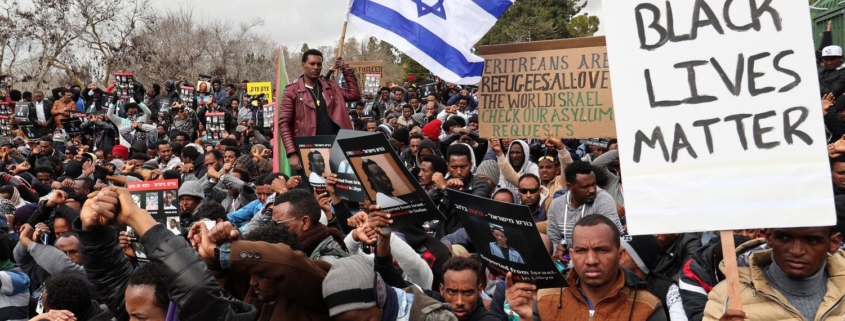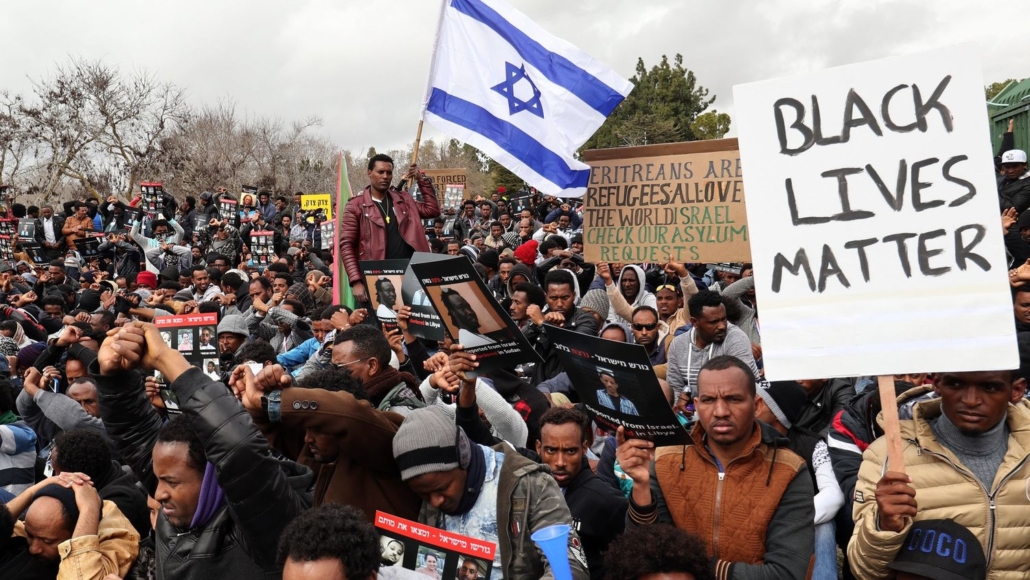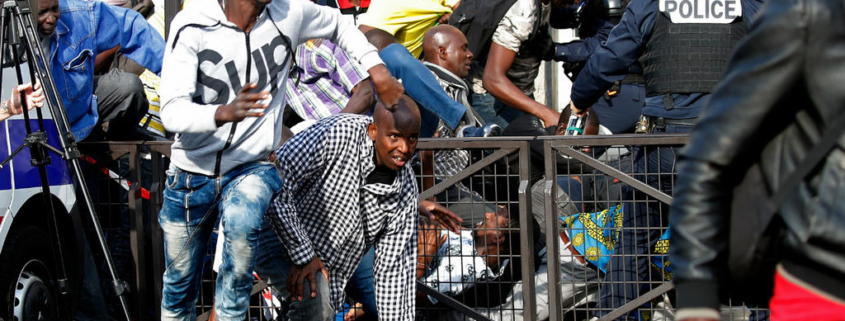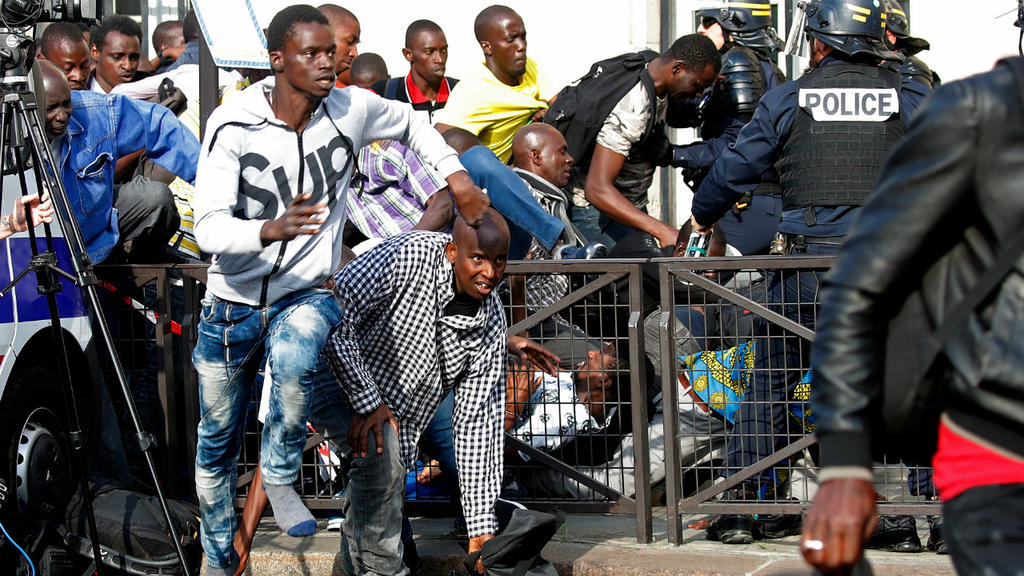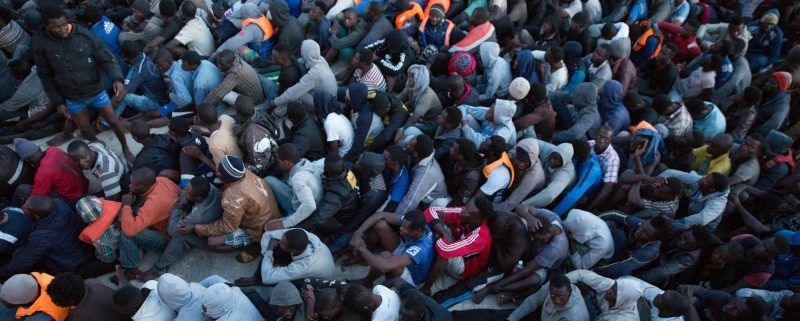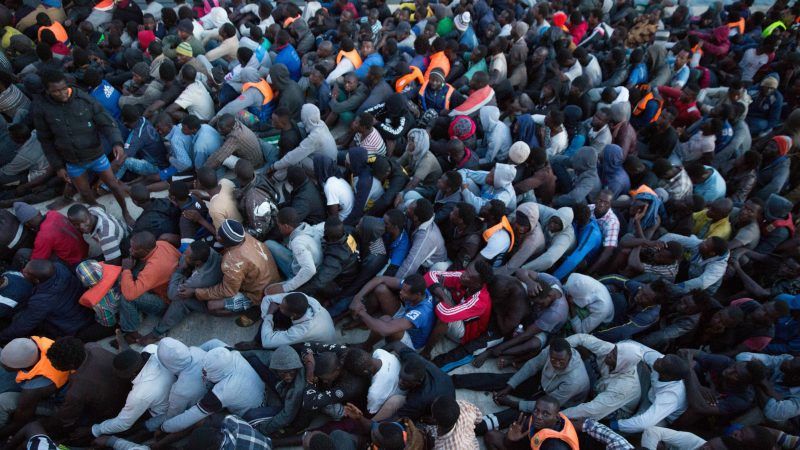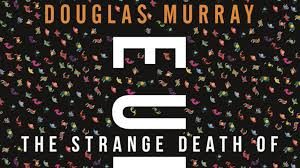The Way Life Should Be? Vol. V: Bad Blood
“As usual, Jews see refugee issues in terms of their own history and perceived interests, not what’s good for the country or its traditional White majority, and ignoring the fraud and economic motives. ‘The Jewish people know what it means to be turned away and to be denied protection.’”—Kevin MacDonald
We continue now with the vast network of individuals and organizations working to “diversify” the state of Maine, maintaining our focus in this installment on the outsized Jewish role in the process.[1] Colby College in Waterville, Maine held a conference in 2015 entitled, “Maine Migrations, Past and Present,” organized in conjunction with Colby’s Maine Jewish History Project and co-sponsored by the NAACP, Catholic Charities, Documenting Maine Jewry, and the Jewish Community Alliance (JCA) of Southern Maine, along with several other organizations. Among the presentations were: “Art, immigrant history, and political engagement” by the Jewish Jo Israelson, Compagna-Sennett Artist-in-Residence at Colby College whose research and art seek to raise awareness of historical Jews in Maine who have helped to “welcome the stranger”; “Children of Holocaust Survivors”; “German Jews of Bangor, 1849-1856”; “Jews in Lewiston-Auburn during the early 20th century” by David Freidenreich, the Pulver Family Associate Professor of Jewish Studies at Colby College and director of its Jewish studies program; and the “Refugees and Asylum-Seekers” symposium moderated by David Greenham, Associate Director of The Holocaust and Human Rights Center of Maine, featuring presentations on the experiences of refugees and asylum-seekers in Maine from Somalia and Burundi, the “experiences of Soviet Jewish Refugees,” and a joint presentation by Catherine Yomoah of the Maine State Office of Multicultural Affairs and Tarlan Ahmadov, the State Refugee Coordinator for Catholic Charities of Maine on refugee resettlement and asylum trends. Greenham has been organizing seminars in the state capital this summer to educate teachers on how to teach the Holocaust and slavery, and how to incorporate advocacy for immigrants’ rights into their lesson plans; there were also “anti-bias” training sessions.
The Maine Jewish Film Festival (MJFF) works with Colby College, the University of Maine Law School, University of Southern Maine, MECA,[2] Bates College, the Maine ACLU, Portland NAACP, the Museum of African Culture, EqualityMaine, Interfaith Youth Alliance, and The Holocaust and Human Rights Center. Among 2019’s distinguished guests were included:
· Lana Alman, HIAS board member, former legal adviser to illegal alien minors, and, as Lead Associate at Booz Allen Hamilton, Lana focuses on projects related to healthcare and immigration, recently overseeing a team of Spanish-language writers and translators for Obamacare to ensure that millions of Spanish-speaking consumers had access to healthcare.
· Alison Beyea, Executive Director at the ACLU of Maine and former employee of the University of Maine Law School.
· Shenna Bellows, state senator and Executive Director of The Holocaust and Human Rights Center; she led the ACLU of Maine as Executive Director for eight years and served as Interim Executive Director for LearningWorks, where Portland Mayor Ethan Strimling served as CEO for 19 years. Most recently, Bellows owned a nonprofit consulting firm providing services to a range of nonprofit organizations ranging from the Maine Women’s Lobby to the Maine Immigrants’ Rights Coalition. She was a key leader on the successful 2012 marriage equality campaign and co-chaired the successful 2011 statewide ballot campaign to restore same day voter registration.
· Lisa Mayer, former Madison Avenue denizen now residing in Auburn, Maine and contributor to the Jewish Daily Forward and the Huffington Post.
With funding from Hyatt, the Law Offices of Joe Bornstein, the Consulate General of Israel to New England, HeadInvest, Epstein Commercial Real Estate, Alliance Bernstein, Colby College Center for Small Town Jewish Life, Documenting Maine Jewry, the Sam L. Cohen Foundation, the Robert and Dorothy Goldberg Foundation, the Moser Family Foundation, Jewish Community Alliance, the Bernard A. Osher Foundation, the Lunder Foundation, the Morris J. and Betty Kaplun Foundation, and the Albert B. Glickman Family Foundation, the MJFF:
supports dialogue and engagement across the state by providing a forum for the discussion and exploration of challenging issues…through [its] educational outreach programs and community partnerships, [it] strives to educate and inspire a diverse audience…In recent years, waves of immigration and shifting demographics have reshaped many parts of our state. MJFF regards these changes as an opportunity to create programming and events that celebrate and build community within an increasingly diverse population…Through new outreach initiatives and strategic partnerships [it] will continue to expand [its] reach and remain at the vanguard of Maine’s cultural community.
The MJFF’s Board of Directors includes representatives of financial institutions, such as Aurora Financial Group Vice President, Chief Compliance Officer, and Investment Advisor Kim Volk. It also includes lawyer Randi Greenwald, short-time Maine resident and volunteer on Obama for Maine and Hillary for Maine Finance Committees, Maine Immigrants Rights Coalition (MIRC), and “other social justice efforts through Congregation Bet Ha’am.”
This phenomenon of out-of-state Jews (to say nothing of the affiliated banks, firms, corporations, and other organizations) relocating to Maine and promptly working to transform their new environs to become more “cosmopolitan” was introduced in the previous installment of this series, and is a pattern of Jewish behavior at least 3,000 years old. Once again Maine serves as a perfect microcosm. Judith Sloan, who is Jewish, is from New York and was drawn to Maine from summering there. She is an immigration advocate and does performances of “Stories of Migration, Refuge and Finding Home. … Co-sponsored by the Unitarian Universalist Church of Brunswick and Beth Israel Congregation in Bath…[with] proceeds to benefit EarSay’s work with immigrant youth and the The Midcoast New Mainers Support Group…an interfaith collaborative offering resettlement support to asylum seekers and refugees in the Bath-Brunswick area.” Also in collaboration is New Mainers Speak, a pro-immigration and -diversity radio show which advocates for the “internationalization” of Maine. Another New Yorker, Portland Mayor Ethan Strimling, was the catalyst for this entire series.
Strimling, it may surprise you to learn, is Jewish, and is not the city’s first Jewish mayor. “Coincidentally” James I. Cohen, attorney specializing in banking and financial services, oversaw Portland becoming the home to the largest community of Sudanese in the United States in his brief stint as mayor of the city. Strimling has ties to the Democratic Socialists of America (DSA) party, and just 22% of his re-election campaign donations so far have come from Portland residents and businesses. Major Strimling donors in this campaign cycle include: the Jewish Jeffrey “Sleazy” Solomon, Democratic candidate for the Florida State House of Representatives, Miami-Dade County, lobbyist, grifter, and tax evader; the Jewish Marc I. Gross, senior counsel at Pomerantz LLP in New York, board member of T’ruah: The Rabbinic Call for Human Rights, and President-Elect of the Institute for Law and Economic Policy (ILEP), a 501(c)(3) we will return to in a later piece; Jewish psychiatrist Marc Shinderman; the Jewish Marc Cohen, Executive Chairman of C4 Therapeutic, co-founder and Chief Executive Officer of Bublup, Inc. and COBRO Ventures, Inc., co-founder and Chairman of Acetylon Pharmaceuticals, Inc. and ONCOPEP, Inc., and co-founder, Chief Executive Officer, and Chairman of OPNET Technologies, Inc.; Roberta Lipsman, Project Coordinator of the United Way of Greater Portland; Kenneth Lewis, Senior Director of MaineHealth; Yusuf Yusuf and Abdullahi Ali of Gateway Community Services; Amod Damle, Senior Recruiter for MTS Systems, a company that relies heavily on H-1B visas; the Jewish attorney Joe Bornstein; Tae Chong of Coastal Enterprises, Inc. (CEI) and Catholic Charities; L’Africana Market LLC; Immanuel Herrmann, digital strategist for the notorious left-wing organization MoveOn.org; notorious political consultant Rich Schlackman; Tim Shannon, attorney at Verrill Dana LLP; Suzanne Botana, wife of Xavier Botana, who is on the Board of Directors for the United Way of Greater Portland and is the Superintendent of Portland’s Public Schools (“as a Cuban refugee, Botana is proud of his district’s diversity”); and Linda Larkin, voice of Princess Jasmine in Disney’s Aladdin (1992).
Strimling is quite the piece of work. While running for office in 2016, Strimling was carrying on an affair with his campaign manager Stephanie Clifford, spending his nights at the Hyatt Place in Portland, with a Clifford who, as Chris Busby reports:
Is a partner and president of Baldacci Communications, a public relations and lobbying firm [my note: they have donated heavily to Strimling’s reelection bid campaign]. One of her two co-partners is Bob Baldacci, the former governor’s brother and a real estate developer who previously led a high-profile effort to redevelop the publicly owned Maine State Pier. The firm’s lengthy client list includes Cate Street Capital, Central Maine Power, the National Resources Council of Maine, and numerous political figures of the past and present. Baldacci Communications continues to do work for Strimling, but the mayor said their role is now limited to filing campaign finance reports. Strimling recently raised the issue of revisiting development of the Maine State Pier. Up till now, his discussions about this inside or outside City Hall have taken place without the participants’ knowledge that Strimling has a romantic relationship with the business partner of one of the prime movers behind the previous effort to privatize this public asset.[3]
Strimling’s co-ethno-religionist James I. Cohen, mayor of Portland from 2005-06, is a partner at Verrill Dana LLP. We will see—and have seen—Verrill Dana crop up again and again throughout this series. Verrill Dana has a robust infrastructure for immigration law, supporting the obtainment of green cards and H-1B visas, corporate Petitions for Immigrant Workers (I-140 petitions) with USCIS to sponsor beneficiaries for U.S. permanent resident status, and the like. It is unsurprising they would have a vested interest in the presence of more immigrants and refugees in Maine. Verrill Dana donates large sums of money to pro-immigration groups such as the United Way, LearningWorks, the Campaign for Justice, Immigrant Legal Advocacy Project (ILAP), the Maine Civil Liberties Union, and the Maine Women’s Fund. Many of Verrill Dana’s attorneys serve on the board of directors or are trustees for organizations such as ILAP, Jackson Labs, MaineHealth, Pine Tree Legal Assistance (PTLA),[4] the Maine Chamber of Commerce, and the United Way.
A major organization to which Ethan Strimling financier Marc I. Gross belongs is T’ruah: The Rabbinic Call for Human Rights, whose mission statement is unanimously-echoed in some form by the Jewish organizations or affiliated organizations we’ve already covered in-depth (CJP-Boston, JCA, Catholic Charities, etc.) and the multitude we haven’t been able to due to length considerations (Lewiston-Auburn Jewish Federation, Portland NAACP, HIAS, the various Jewish congregations and synagogues, the ADL, Bates College, etc.):
The Torah teaches the obligation to love and care for the immigrant, just as God does… The ancient rabbis taught that the city of Sodom was considered the epitome of evil because the residents made laws prohibiting kindness to strangers. Welcoming immigrants and strangers remains a core Jewish value, as well as an American one. … Too many Jews died after being trapped in Europe after the U.S. borders closed in 1924 to Jews and members of other ethnic groups. We know that immigration policy can be a matter of life or death. T’ruah takes an immigrant-led, human-rights-based, and Jewishly-informed approach to immigration issues. We support comprehensive immigration reform in the United States that will provide a path to citizenship for our country’s 11 million undocumented immigrants…[We] oppose the use of the criminal justice system as a means of immigration enforcement…Campaign decisions are influenced by the direction of the movement from those most affected by immigration and refugee policies; we strive to ensure that our actions align with and further the goals of immigrant-led organizations. Doing so strengthens the fabric of our interfaith, interracial, interclass society, and close collaboration demonstrates an understanding of immigrant communities as neighbors and friends — not as “others.” T’ruah works as part of an interfaith network to mobilize synagogues and other communities to protect those facing deportation or other immigration challenges. Through our Mikdash (Sanctuary) Network, communities pledge to take concrete actions, which may include legal support, housing, financial help, and other assistance for immigrants at risk of deportation. We connect congregations to local sanctuary networks, so that our communities can be in relationship with immigrant communities and with other communities of faith, and can provide the most effective support for neighbors facing immigration challenges.[5]
This is obvious sophistry to anyone aware of the “Jewish Question.” However, their propaganda is sufficiently effective as to deceive the majority of the goyim. Look no further than the Holocaust—which has become the supreme cultural icon of the West with the power to end any and all arguments related to diversity (again and again and again). Of course, no one ever invokes the Shoah when White minorities are dispossessed and slaughtered unless it’s to somehow implicate those Whites and justify their destruction.
The charade is not always so explicit, however; as Mark Steyn put it, “No one ever complains about the lack of French restaurants in Mogadishu,” but the (former) lack of Mogadishu in Acadian-French regions of Maine is a serious problem the Jewish organizations and neo-liberal establishment have been more than happy to rectify, even if it means destroying the Acadian-French ethnos. The ultimate erasure of this unique ethnicity with its own culture, heritage, and the like in the name of “diversity” is tragically just one more of the morbidly-perverse contradictions of laissez-faire genocide. As George W. Bush once taunted the Iraqis in his administration’s post-9/11 bloodbath by saying, when he may as well have been also talking about their decision to green-light the flood of Somalis into America: “Bring ’em on!” Would that we had a say in the matter, but in neo-liberal “democracy” that’s simply not possible.
Reposted with permission from The Anatomically Correct Banana.
[1] Though remember, there are ample non-Jewish beneficiaries of the neo-liberal machine. The Jews could not do this alone. In any case, what’s good for the Jews is virtually never good for the gander, though if one is willing to collaborate they might well enjoy the privileges of being a philo-Semitic courtier insofar as they remain useful.
[2] The Maine College of Art (MECA) sponsored an event entitled “Making Migration Visible: Traces, Tracks & Pathways,” with an infusion of funding from several Jewish philanthropic organizations; the tone of the event was very much in line with the seemingly-ubiquitous open borders propaganda we are being conditioned to believe, and there was, as one might expect, a heavy reliance on exhibits connecting the “Jewish experience” to the “struggles” of today’s state- and corporate-sanctioned arrivals to Maine. Some of these exhibits included “Dorothea Rabkin: Tragedy to Transformation” about Holocaust refugees; “Maine + Jewish: Two Centuries”; and a documentary series by the Jewish David Grubin “reflecting that ‘once, there was no such thing as an illegal immigrant. If you could get here, you could stay,’ Prof. [Donna] Gabaccia notes that, from the start of U.S. history, immigrants were recognized as necessary to the country’s economic growth.”
[3] https://thebollard.com/2016/02/24/the-strimling-affair/
[4] “Pine Tree Legal Assistance (PTLA) is a non-profit law organization dedicated to ‘providing high quality, free, civil legal assistance to low-income people in Maine.’ Committed to the principle that ‘all Mainers have access to justice,’ PTLA aims to ensure ‘that state and federal laws affecting poor people are enforced while also addressing the systemic barriers to justice that low-income Mainers face.’” https://www.lewistonmaine.gov/DocumentCenter/View/8885/REPORT—ImmigrantandRefugeeIntegrationandPolicyDevelopmentWorkingGroupFinalReport

